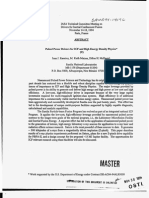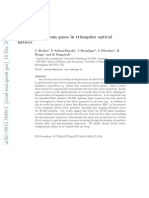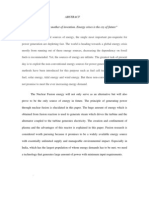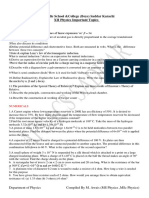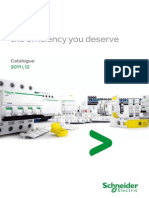The Wendelstein 7-X Fusion Stellarator Experiment: Mag Fus Energy PG 8
The Wendelstein 7-X Fusion Stellarator Experiment: Mag Fus Energy PG 8
Uploaded by
api-368863285Copyright:
Available Formats
The Wendelstein 7-X Fusion Stellarator Experiment: Mag Fus Energy PG 8
The Wendelstein 7-X Fusion Stellarator Experiment: Mag Fus Energy PG 8
Uploaded by
api-368863285Original Title
Copyright
Available Formats
Share this document
Did you find this document useful?
Is this content inappropriate?
Copyright:
Available Formats
The Wendelstein 7-X Fusion Stellarator Experiment: Mag Fus Energy PG 8
The Wendelstein 7-X Fusion Stellarator Experiment: Mag Fus Energy PG 8
Uploaded by
api-368863285Copyright:
Available Formats
The Wendelstein 7-X Fusion Stellarator Experiment
Olivia McGoldrick, May 24th 2020
The Wendelstein 7-X Fusion Stellarator Experiment provides a clever alternative
to traditional tokamak style magnetic confinement fusion reactors. Given the
experiment's success over the past 5 years, it’s not an understatement to say that
it’s a leading experiment in the race for clean fusion energy power plants in the
coming decades. This report overviews several publications from the W7-X team
as well as a recent book on the status of nuclear fusion as a field. I will discuss
W7-X’s design and how it compares to the similar Tokamak fusion experiments
and what successes W7-X has had since coming online in 2015, followed by a
discussion of the future of the experiment
Introduction
Likely the most common approach to achieving nuclear fusion, magnetic confinement reactors
utilize superconducting magnetic rings to create a magnetic field capable of holding an ionized
plasma of tritium and deuterium ions. The reaction byproducts of this fusion involve an alpha
particle and a neutron. The neutron contains 4/5 of the released energy (17.6MeV) and will go
towards heating the reactor housing and the alpha particle is recycled to reheat non fused plasma
to sustain the reaction.1 A “good” magnetic confinement reactor should be able to maintain
enough of the charged alpha particles for heating the plasma further such that the reaction
becomes self-sustaining.
In order to further understand the marvel of engineering that is Wendelstein 7-X, it’d be useful to
briefly overview the plasma physics principles behind their design and operation. Heating of the
plasma comes generally from two sources, alpha heating (P 𝛂) and auxiliary heating (PAUX) used
for the initial heating up to fusion capable temperatures (~105K).3 The ratio of these two values
dictate the Q of a reactor which determines efficiency of the reactor with a Q of 1 meaning a
reaction broke even and is self sustaining (Q = P𝛂 / PAUX). The fusion reaction is shown below.
Approximately 14MeV is carried by the neutron and results in the heating of internal shielding
while the remaining 3.6MeV is ideally utilized for alpha heating when. The problem lies in
MagnetoHydroDynamic (MHD) instabilities.6 The most common shape for magnetic
confinement reactors is a torus, often referred to as Tokamaks. However, this toroidal field must
be twisted in such a way that any one given plasma path must rotate through the range of radii
allowing even treatment of the plasma. Tokamaks complete this twist through the use of a
transformer running through the center of the torus, whereas stellarators and specifically W7-X
have an entirely unique approach, utilizing non planar magnetic coils and special geometries.
1 Mag Fus Energy pg 8
The Design of W7-X vs. Traditional Tokamaks
The need to twist the toroidal magnetic field leads to many instabilities that complicate the
running of magnetic confinement reactors. One such instability is the drift of alpha particles,
where they become trapped in orbits that prevent effective heating of the fuel. Another key flaw
in tokamaks is the use of the transformer to achieve the rotational transform of the toroidal field.
It’s costly in energy to run as well as having the inability to run continuously.
W7-X however, utilizes a 5-fold quasi axisymmetric field that has been mathematically
optimized by supercomputers such that it has no MHD instabilities and the plasma orbits are
stable. This allows W7-X to run with fields of approximately 3T whereas a Tokamak of similar
size would likely run at around 7T. Through the use of a combination of 20 planar
superconducting coils as well as 50 non planar coils are used to shape the unique field shown in
fig 1. Of the 50 non planar coils, there are 5 different uniquely shaped types, of which I will not
go into detail on. Each one-fifth slice of the ring consists of two geometrically identical flipped
half models consisting of 7 coils each.2 A cross section of this quasi-axisymmetric magnetic field
torus reveals another field optimization of W7-X. Each “shell” or magnetic surface has an
approximately constant field along the entire path of a traveling particle.
In principle, you could reconstruct the whole ring from one of these flipped half modules,
making the ring in a sense 10-fold quasi-axisymmetric. One half module consists of a shape
changing field where one end has a cross section of an elongated bean shape and the other end
has a more triangular cross section of its component magnetic field. There are several other types
of coils/components that contribute to greater stability of the magnetic flux and thus the plasma
stability times including diamagnetic loops, Rogowski coils, compensation coils and saddle coils
that are beyond the scope of this paper. See Endler M. et al. for more detailed mechanics of the
magnetic systems of W7-X.
Fig 1. CAD image of the outermost magnetic flux shell in the plasma chamber of the Wendelstein 7-X experiment.
The blue rings represent the unique non planar superconducting magnetic coils used to create the field. The 20
planar coils are not shown. [Magnetic Fusion Energy pg 497]6
The Success of Wendelstein 7-X
Part of what makes W7-X so successful other than it’s highly optimized magnetic coil
system is it’s leading edge heating systems which consist of three parts: a hybrid Ion
Cyclotron Range of Frequency - Neutral Beam Injection (ICRF-NBI), Electron Cyclotron
Resonance Heating (ECRH), and Ion Cyclotron Resonance Heating (ICRH). The first to be
operation of these components was the NBIs in which high energy plasma of fusion material
like Tritium and Deuterium are accelerated and neutralized via the addition of electrons
before being injected into the plasma vessel. The hybrid ICRF-NBI heating system allows
greater heating than pure ICRH nor pure NBI, allowing temperatures high enough to study
high performance (high-ꞵ) plasma’s and the instabilities that arise in the form of toroidal
Alfvén eigenmodes. ICRH and ECRH heating involve the external injection of radio waves
resonant with either the ions or electrons present in the plasma vessel. In total, heating
power is still quite limited in W7-X.
When W7-X first came online in 2015 with many drawbacks like an incomplete heat and particle
exhaust system consisting of five poloidal graphite limiters, and the rest being a combination of
steel and CuCrZr walls, the plasma ran remarkably well, achieving a number density of
3x1019 [m-3]. Phase 2 came with the installation of ten modular island diverters which curve to
the shape of the plasma vessel (Fig 2). These diverters are manufactured out of graphite tiles and
carbon-fiber reinforced carbon and expected to be able to withstand a heat flux as high as
10 [MWm-2].6, 8
Fig 2. Schematic of island diverter modules highlighting where the plasma vessel has a bean shaped cross section
versus a triangular cross section. [Magnetic Fusion Energy pg 500]
With the installation of the diverter units, W7-X was also able to achieve plasmas with an
average ꞵ of 1-3%, which still allowed W7-X to set records in plasma confinement in
comparison to other stellarator devices.
The Future of Wendelstein 7-X
The next phase of W7-X’s operation is set to increase the heating power of the reactor, which
would allow for high ꞵ plasmas of up to 5%. While the heating power of the reactor is being
upgraded, water cooling to the diverter units and graphite tiling will also be installed, allowing
for even greater control of plasma density and quality. The successes so far have proved the
inherently steady state capability of plasmas in stellarators, If these tests continue with the
momentum of success that the stellarator has had in its first two phases, then it will prove the
efficacy of magneto-hydro-dynamically optimized quasi-axisymmetric stellerators as potential
fusion power plants.
Current Sources
[1] A. Fasoli et. al. “Computational challenges in magnetic-confinement fusion physics” Nature
Physics (2016)
[2] Endler M. et. al. “Engineering design for the magnetic diagnostics of Wendelstein 7-X”
Fusion Engineering and Design 100 (2015)
[3] H. W. Patten et. al. “Identification of an Optimized Heating and Fast Ion Generation Scheme
for the Wendelstein 7-X Stellarator” Phys. Rev. Let. 124, 155001 (2020)
[4] Jürgen Nührenberg et. al. “Development of quasi-isodynamic stellarators” Plasma Phys.
Control. Fusion 52 124003 (2010)
[5] Maurizio Gasparotto et. al. “Wendelstein 7-X—Status of the project and commissioning
planning”
[6] Neilson, George H. Magnetic Fusion Energy (book) Chapters 2, 16, 19 (2016)
[7] Viktor Bykov “Engineering Challenges of Wendelstein 7-X Mechanical Monitoring During
Second Phase of Operation”
[8] T. Klinger et. al. “Overview of first Wendelstein 7-X high-performance operation” Nucl.
Fusion 59 112004 (2019)
You might also like
- 1977 Persinger and Lafreniere Space Time Transients and Unusual EventsDocument39 pages1977 Persinger and Lafreniere Space Time Transients and Unusual EventsRahul BanerjeeNo ratings yet
- PhysRevLett 130 220001Document6 pagesPhysRevLett 130 220001Reslane KhassouaniNo ratings yet
- Simulation of Complex Non-Linear Structures in Large Scale AnalysisDocument13 pagesSimulation of Complex Non-Linear Structures in Large Scale AnalysisNikola JaksicNo ratings yet
- haines2005Document12 pageshaines2005vurdalak768No ratings yet
- Shunt Reactor VibrationDocument8 pagesShunt Reactor VibrationmehmeteeeNo ratings yet
- Juan J. Ramirez, M. Keith Matzen and Dillon H. McDaniel - Pulsed Power Drivers For ICF and High Energy Density PhysicsDocument18 pagesJuan J. Ramirez, M. Keith Matzen and Dillon H. McDaniel - Pulsed Power Drivers For ICF and High Energy Density PhysicsCola7890No ratings yet
- A Linear AC Trap For Polar Molecules in Their Ground StateDocument9 pagesA Linear AC Trap For Polar Molecules in Their Ground Statehorner32No ratings yet
- Jeremy P Chittenden - The Z-Pinch Approach To FusionDocument5 pagesJeremy P Chittenden - The Z-Pinch Approach To FusionCola7890No ratings yet
- Press Release CERNDocument3 pagesPress Release CERNppNo ratings yet
- Stellarator Fusion Rectors OverviewDocument7 pagesStellarator Fusion Rectors OverviewroberoayonNo ratings yet
- 250 LN 14Document94 pages250 LN 14ahmed372416No ratings yet
- Bercioux 2015Document32 pagesBercioux 2015Santiago Galván y GarcíaNo ratings yet
- Yu 1997 0177Document3 pagesYu 1997 0177Particle Beam Physics LabNo ratings yet
- Vito Lancellotti Et Al - Radiofrequency Plasma Thrusters: Modelling of Ion Cyclotron Resonance Heating and System PerformanceDocument8 pagesVito Lancellotti Et Al - Radiofrequency Plasma Thrusters: Modelling of Ion Cyclotron Resonance Heating and System PerformanceOlmnopNo ratings yet
- An Equivalent Circuit Model of A Plasma Core InductorDocument6 pagesAn Equivalent Circuit Model of A Plasma Core InductorEdwin CerveraNo ratings yet
- Antiproton Annihilation Propulsion: AbstractDocument6 pagesAntiproton Annihilation Propulsion: AbstractDarani PriyaNo ratings yet
- Forinash 2002Document8 pagesForinash 2002eduardovb2023No ratings yet
- M.K. Matzen Et Al - The Refurbished Z Facility: Capabilities and Recent ExperimentsDocument3 pagesM.K. Matzen Et Al - The Refurbished Z Facility: Capabilities and Recent ExperimentsCola7890No ratings yet
- PhysicsDocument11 pagesPhysicsnassreal01No ratings yet
- Modeling The Yildiz Motor: II. Electromagnetic SingularitiesDocument4 pagesModeling The Yildiz Motor: II. Electromagnetic SingularitiesChad Ashley VandenbergNo ratings yet
- Sekutowicz 2005 617Document12 pagesSekutowicz 2005 617Particle Beam Physics LabNo ratings yet
- Energetic Particles in Spherical TokamakDocument23 pagesEnergetic Particles in Spherical Tokamakusman ullahNo ratings yet
- C Becker Et Al - Ultracold Quantum Gases in Triangular Optical LatticesDocument19 pagesC Becker Et Al - Ultracold Quantum Gases in Triangular Optical LatticesKuiasmNo ratings yet
- Fusion Engineering and DesignDocument10 pagesFusion Engineering and DesignMahdi EslamiNo ratings yet
- O_Portugall_1999_J._Phys._D__Appl._Phys._32_2354Document14 pagesO_Portugall_1999_J._Phys._D__Appl._Phys._32_2354michaelpan2002No ratings yet
- Phys Status Solidi B 2010 BansmannDocument9 pagesPhys Status Solidi B 2010 BansmannIDhil AndiNo ratings yet
- Thermal Activation of Ferroelectric Switching.......Document8 pagesThermal Activation of Ferroelectric Switching.......AnaghaNo ratings yet
- Moray SecretDocument13 pagesMoray SecretOvidiu FratuNo ratings yet
- Nuclear BatteryDocument8 pagesNuclear Batteryకృష్ణ మురళిNo ratings yet
- The Advent of Clean Nuclear Fusion - Superperformance Space Power and Propulsion (Robert W Bussard)Document15 pagesThe Advent of Clean Nuclear Fusion - Superperformance Space Power and Propulsion (Robert W Bussard)THE NIKOLA TESLA INSTITUTENo ratings yet
- Anti GravityDocument0 pagesAnti Gravitydewidewi76No ratings yet
- 4 BJNanotechDocument6 pages4 BJNanotechqusiy.algalibyNo ratings yet
- Ding 1999 0167Document3 pagesDing 1999 0167Particle Beam Physics LabNo ratings yet
- Necessity Is The Mother of Invention. Energy Crises Is The Cry of FutureDocument14 pagesNecessity Is The Mother of Invention. Energy Crises Is The Cry of FutureBhaskar YadavNo ratings yet
- Zae210481500 PDFDocument28 pagesZae210481500 PDFAJER JOURNALNo ratings yet
- Physics Magnetic BottlesDocument6 pagesPhysics Magnetic BottlesAin ZahraNo ratings yet
- Wu 2019Document13 pagesWu 2019Jorge LasaveNo ratings yet
- Russian SEGDocument9 pagesRussian SEGrichcollins6217No ratings yet
- VECC Cryogenic Penning Ion Trap: A Status ReportDocument2 pagesVECC Cryogenic Penning Ion Trap: A Status ReportSaswati BanerjeeNo ratings yet
- Perovskite-Silicon Two-Terminal Tandem SolarDocument3 pagesPerovskite-Silicon Two-Terminal Tandem Solarjose manuel acosta saavedraNo ratings yet
- Lectu Ra 1 Ferro Electric MaterialsDocument23 pagesLectu Ra 1 Ferro Electric MaterialsLola Centeno CentenoNo ratings yet
- Variable Specific Impulse Magnetoplasma Rocket - Wikipedia, The Free EncyclopediaDocument9 pagesVariable Specific Impulse Magnetoplasma Rocket - Wikipedia, The Free EncyclopediaB.HNo ratings yet
- Faraday PDFDocument107 pagesFaraday PDFfabrice mellantNo ratings yet
- XII Physics Important Topic List 2024Document2 pagesXII Physics Important Topic List 2024khaanianasNo ratings yet
- Preprints201907 0080 v2Document11 pagesPreprints201907 0080 v2Zvone BozinovskiNo ratings yet
- Electrical-Model of ADITYA-U TokamakDocument8 pagesElectrical-Model of ADITYA-U TokamakRija RehmanNo ratings yet
- PhysRevX 3 021012 PDFDocument7 pagesPhysRevX 3 021012 PDFmojaNo ratings yet
- IE Pyramid PaperDocument5 pagesIE Pyramid PaperStefan Belchuga NikolicNo ratings yet
- A. Ciardi Et Al - The Evolution of Magnetic Tower Jets in The LaboratoryDocument34 pagesA. Ciardi Et Al - The Evolution of Magnetic Tower Jets in The LaboratoryCola7890No ratings yet
- jresv69Cn4p287_A1bDocument16 pagesjresv69Cn4p287_A1bjnrvilhenaNo ratings yet
- Optical Lattices, Ultracold Atoms and Quantum Information ProcessingDocument29 pagesOptical Lattices, Ultracold Atoms and Quantum Information ProcessingLivardy WufiantoNo ratings yet
- Nuclear Fusion Reactor Assignment ?Document9 pagesNuclear Fusion Reactor Assignment ?Zarish MaqboolNo ratings yet
- Tokamek PLASMA PHYSICSDocument11 pagesTokamek PLASMA PHYSICSSäjidëë KisÅnNo ratings yet
- Molecular-Dynamics Simulation of Growth of Nanocrystals in An Amorphous MatrixDocument6 pagesMolecular-Dynamics Simulation of Growth of Nanocrystals in An Amorphous Matrixsabrine hamriNo ratings yet
- 2010 Thermally Activated Switching Kinetics in Second-Order Phase Transition FerroelectricsDocument10 pages2010 Thermally Activated Switching Kinetics in Second-Order Phase Transition FerroelectricsAnaghaNo ratings yet
- Squid Magnetomatery CombineDocument12 pagesSquid Magnetomatery CombinejihannauvalaNo ratings yet
- Nuclear Fusion: Germany's Wendelstein 7-X Stellarator' Is Operating As ExpectedDocument5 pagesNuclear Fusion: Germany's Wendelstein 7-X Stellarator' Is Operating As ExpectedDanica HarinaNo ratings yet
- Negative Mass and Negative Refractive Index in Atom Nuclei - Nuclear Wave Equation - Gravitational and Inertial Control: Part 4: Gravitational and Inertial Control, #4From EverandNegative Mass and Negative Refractive Index in Atom Nuclei - Nuclear Wave Equation - Gravitational and Inertial Control: Part 4: Gravitational and Inertial Control, #4No ratings yet
- On the quantum theory of radiation and the structure of the atomFrom EverandOn the quantum theory of radiation and the structure of the atomNo ratings yet
- Negative Mass and Negative Refractive Index in Atom Nuclei - Nuclear Wave Equation - Gravitational and Inertial Control: Part 2: Gravitational and Inertial Control, #2From EverandNegative Mass and Negative Refractive Index in Atom Nuclei - Nuclear Wave Equation - Gravitational and Inertial Control: Part 2: Gravitational and Inertial Control, #2No ratings yet
- Routine Test-Acceptance Criteria IEC (Power Transformer)Document2 pagesRoutine Test-Acceptance Criteria IEC (Power Transformer)Yingyong_s75% (4)
- Engineering Electromagnetics 8th Edition William H. Hayt Original (235 241)Document7 pagesEngineering Electromagnetics 8th Edition William H. Hayt Original (235 241)deviNo ratings yet
- Single Function Timers Model No. 740Document6 pagesSingle Function Timers Model No. 740jose marcanoNo ratings yet
- 3.2.4 Safe Access To The ADU: Radiation Hazard: Site PreparationDocument10 pages3.2.4 Safe Access To The ADU: Radiation Hazard: Site PreparationVladimir Ban'No ratings yet
- Introduction To RadioactivityDocument3 pagesIntroduction To Radioactivitydeshmukhradhika146No ratings yet
- Student Exploration: Element Builder: Samara VandeverDocument4 pagesStudent Exploration: Element Builder: Samara VandeverSamara VandeverNo ratings yet
- Raman PPT 2Document31 pagesRaman PPT 2rs1114193No ratings yet
- LSA 43.2/44.2 - 4-POLE: AlternatorsDocument20 pagesLSA 43.2/44.2 - 4-POLE: Alternatorshafid CJSPNo ratings yet
- Schneider Acti9 MCBsDocument238 pagesSchneider Acti9 MCBsbrightstardustNo ratings yet
- 50 Checkpoints Physics JEE 2025Document2 pages50 Checkpoints Physics JEE 2025gkmsi2681No ratings yet
- Electrostatic Notes (Class-11)Document25 pagesElectrostatic Notes (Class-11)Rintu SahaNo ratings yet
- Axial Coated Inductors DatasheetDocument1 pageAxial Coated Inductors DatasheetPerico PerezNo ratings yet
- 7.1 7.2 (49 Marks) : 1. (1 Mark)Document13 pages7.1 7.2 (49 Marks) : 1. (1 Mark)Abdulaziz HalabiNo ratings yet
- ETI 2202 - Electrical Machines I-PRINTREADYDocument4 pagesETI 2202 - Electrical Machines I-PRINTREADYAlie FavourNo ratings yet
- EC8451 QB - by WWW - Easyengineering.net 1Document12 pagesEC8451 QB - by WWW - Easyengineering.net 1Shiva ThumulaNo ratings yet
- Homework 7: Important InformationDocument2 pagesHomework 7: Important InformationBob BelcherNo ratings yet
- Manual - Sm-T4.5r-Motor-Install 20150606Document20 pagesManual - Sm-T4.5r-Motor-Install 20150606aboediartoNo ratings yet
- Landau-Lifshitz-Gilbert Equation - WikipediaDocument1 pageLandau-Lifshitz-Gilbert Equation - WikipediafonckvalentinNo ratings yet
- 課堂複習 Light Waves 光波 - 下載筆記Document4 pages課堂複習 Light Waves 光波 - 下載筆記yylamNo ratings yet
- Juki AMS-205C, - 206CDocument40 pagesJuki AMS-205C, - 206Cbách hàNo ratings yet
- A Balanced RF Power Amplifier Using The ImprovemenDocument11 pagesA Balanced RF Power Amplifier Using The ImprovemenLOUKILkarimNo ratings yet
- 03 Direct On-Line Starter (D.o.l)Document10 pages03 Direct On-Line Starter (D.o.l)Muhammad NaguibNo ratings yet
- L&T Panel Accessories Price List 01JUL2017Document44 pagesL&T Panel Accessories Price List 01JUL2017TarunPatraNo ratings yet
- DielectricsDocument7 pagesDielectricsioanNo ratings yet
- RPT Term 2 PhysicsDocument6 pagesRPT Term 2 PhysicspunithaNo ratings yet
- Connections and Composition of LV, MV, HV Capacitor BanksDocument7 pagesConnections and Composition of LV, MV, HV Capacitor BanksAbdul Mohid SheikhNo ratings yet
- Tutorial 2Document4 pagesTutorial 2Victor HabiyambereNo ratings yet
- Eee 1102Document26 pagesEee 1102Rayhanul Islam LamunNo ratings yet
- Nikola Tesla S True Wireless A ParadigmDocument9 pagesNikola Tesla S True Wireless A ParadigmvirfulgurNo ratings yet





